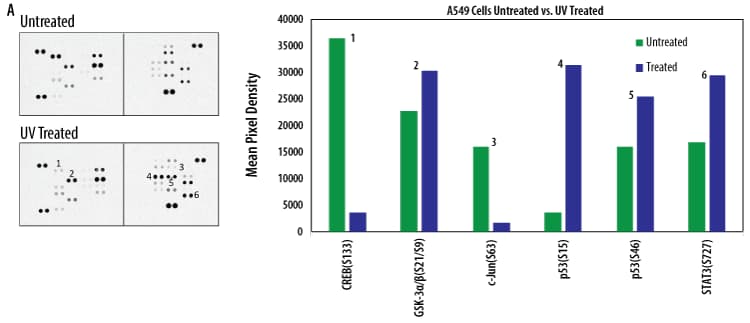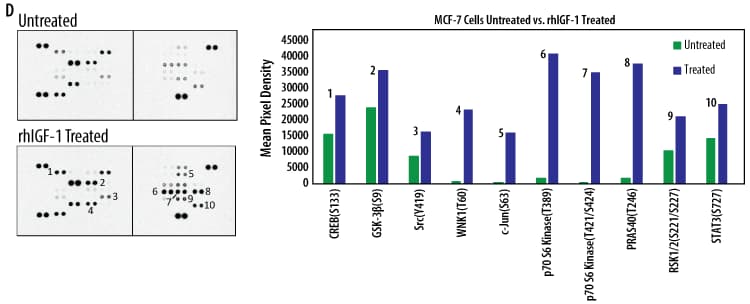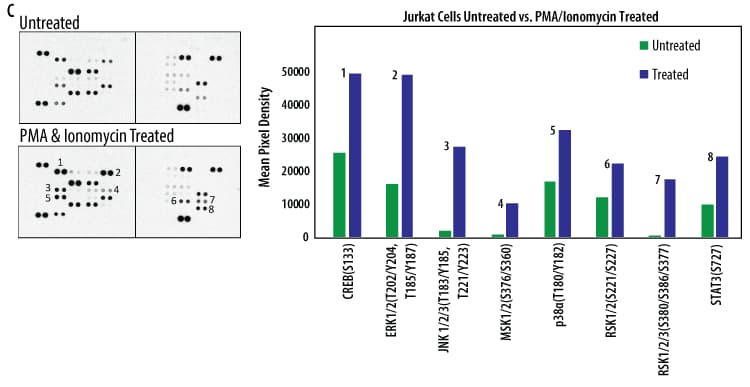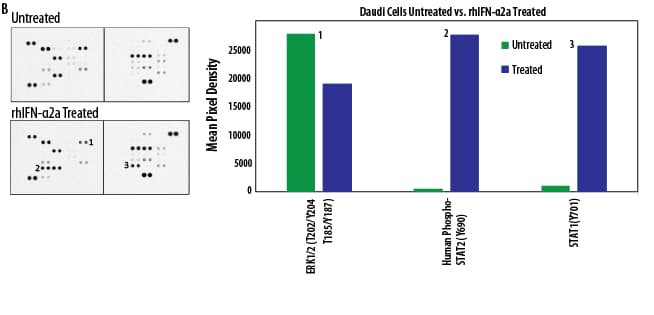 全部商品分类
全部商品分类



 下载产品说明书
下载产品说明书 下载SDS
下载SDS 用小程序,查商品更便捷
用小程序,查商品更便捷


 收藏
收藏
 对比
对比 咨询
咨询Scientific Data
 View Larger
View LargerDetection of Human Protein Kinase Phosphorylation in A549 Cell Line. A549 human lung adenocarcinoma cells were either left untreated or exposed to 50 J/m2 of UV light followed by a 24 hour recovery before lysis.
 View Larger
View LargerDetection of Human Protein Kinase Phosphorylation in Daudi Cell Line. Daudi human B cell lymphoma cells were either left untreated or treated with 500 U/ml Recombinant Human IFN-alpha 2a (R&D Systems, Catalog # 11100-1) for 5 minutes.
 View Larger
View LargerDetection of Human Protein Kinase Phosphorylation in Jurkat Cell Line. Jurkat human acute T cell leukemia cells were either left untreated or treated with 100 ng/mL PMA and 0.5 mM Ionomycin for 20 minutes.
 View Larger
View LargerDetection of Human Protein Kinase Phosphorylation in MCF-7 Cell Line. MCF-7 human breast cancer cells were either left untreated or treated with 100 ng/mL of recombinant human IGF-1 (R&D Systems®, Catalog # 291-G1) for 1 hour.
Proteome Profiler Human Phospho-Kinase Array Kit Summary
A membrane-based antibody array for the parallel determination of the relative levels of human protein kinase phosphorylation. Validated for analyte detection in cell lysates.
Key Benefits
- Detects phosphorylation of 37 human kinases and total amounts of 2 related proteins simultaneously
- Requires no specialized equipment
Principle of the Assay
The Proteome Profiler Human Phospho-Kinase Array Kit is a membrane-based sandwich immunoassay. Capture antibodies spotted in duplicate on nitrocellulose membranes bind to specific target proteins present in the sample (Step 1). Captured proteins are detected with biotinylated detection antibodies (Step 2) and then visualized using chemiluminescent detection reagents (Step 3). The signal produced is proportional to the amount phosphorylation in the bound analyte.
Why Use an Antibody Array to Detect Receptor Phosphorylation?
Determining the phosphorylation of multiple kinases in a single sample can be expensive, time consuming and can require specialized equipment. Performing multiple immunoprecipitations and Western blots requires time, labor, and reagents. The use of a multiplex antibody array to detect multiple phosphorylations in a single sample can be cost-effective and also save time and sample.
Each Human Phospho-Kinase Antibody Array Kit contains most of the necessary components for a ready-to-run assay without the need for specialized equipment.
- 8 Array Membranes (4 of membrane A and 4 of membrane B)
- 8-Well Multi-dish
- Lysis Buffer
- Array Buffers
- Wash Buffer
- Detection Antibody Cocktail A
- Detection Antibody Cocktail B
- Streptavidin-HRP
- Chemiluminescent Detection Reagents
- Transparency Overlay Template
- Detailed product datasheet with protocol
For a complete list of the kit contents and necessary materials, please see the Materials Provided/Other Supplies Required sections of the product datasheet.
Stability and Storage
Store the unopened kit at 2°C to 8°C. Do not use past kit expiration date.
| Simultaneously detect the relative phosphorylation of these proteins in a single sample. | ||
| Akt 1/2/3 (S473) | HSP60 | PRAS40 (T246) |
| Akt 1/2/3 (T308) | JNK 1/2/3 (T183/Y185, T221/Y223) | Pyk2 (Y402) |
| beta-Catenin | Lck (Y394) | RSK1/2 (S221/S227) |
| Chk-2 (T68) | Lyn (Y397) | RSK1/2/3 (S380/S386/S377) |
| c-Jun (S63) | MSK1/2 (S376/S360) | Src (Y419) |
| CREB (S133) | p38 alpha (T180/Y182) | STAT1 (Y701) |
| EGF R (Y1086) | p53 (S15) | STAT2 (Y690) |
| eNOS (S1177) | p53 (S392) | STAT3 (S727) |
| ERK1/2 (T202/Y204, T185/Y187) | p53 (S46) | STAT3 (Y705) |
| Fgr (Y412) | P70 S6 Kinase (T389) | STAT5a/b (Y699) |
| GSK-3 alpha/beta (S21/S9) | p70 S6 Kinase (T421/S424) | STAT6 (Y641) |
| GSK-3 beta (S9) | PDGF R beta (Y751) | WNK-1 (T60) |
| HSP27 (S78/S82) | PLC gamma-1 (Y783) | Yes (Y426) |
Assays for analytes represented in the Human Phospho-Kinase Array Kit
| Analyte | DuoSet® IC ELISA Development Systems (Total) | DuoSet® IC ELISA Development Systems (Phospho) | Quantikine® ELISA Kits |
| Akt (S473) | DYC887B | ||
| Akt (T308) | |||
| beta-Catenin | DYC1329 | ||
| Chk2 (T68) | DYC1626 | ||
| c-Jun (S63) | |||
| CREB (S133) | DYC2510 | ||
| EGF R (Y1086) | DYC1854 | DEGFR0 | |
| eNOS (S1177) | |||
| ERK1/2 (T202/Y204, T185/Y187) | DYC1018B | ||
| Fgr (Y412) | |||
| GSK-3 beta (S9) | |||
| GSK-3 alpha/beta (S21/S9) | DYC2157 | DYC2630 | |
| HSP27 (S78/S82) | DYC1580 | DYC2314 | |
| HSP60 | DYC1800 | ||
| JNK pan (T183/Y185, T221/Y223) | DYC1205 | DYC1387 | |
| Lck (Y394) | |||
| Lyn (Y397) | DYC3936 | ||
| MSK1/2 (S376/S360) | |||
| p38 alpha (T180/Y182) | DYC8691B | DYC869B | |
| p53 (S15) | DYC1043 | DYC1839 | |
| p53 (S46) | DYC1043 | DYC1489 | |
| p53 (S392) | DYC1043 | DYC2996 | |
| p70 S6 Kinase (T389) | DYC896 | ||
| p70 S6 Kinase (T421/S424) | DYC8962 | DYC8965 | |
| PDGF R beta (Y751) | DYC385 | DYC3096 | |
| PLC gamma-1 (Y783) | |||
| PRAS40 (T246) | DYC6890 | ||
| PYK2 (Y402) | |||
| RSK1/2 (S221/S227) | |||
| RSK1/2/3 (S380/S386/S377) | DYC889B | ||
| Src (Y419) | DYC2685 | ||
| STAT1 (Y701) | |||
| STAT2 (Y690) | |||
| STAT3 (S727) | |||
| STAT3 (Y705) | DYC4607B | ||
| STAT5a/b (Y694/Y699) | |||
| STAT6 (Y641) | |||
| WNK-1(T60) | DYC4720 | ||
| Yes (Y426) | DYC3929 |







